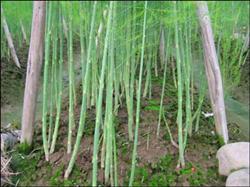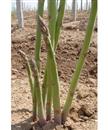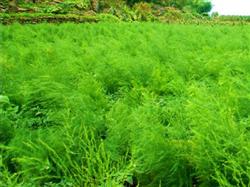High-yield cultivation and management techniques of asparagus

Asparagus is one of the most efficient economic crops, which can be harvested for more than 10 years at one time. The annual bamboo shoot collection per mu generally reaches 2300 kg, and the output value per mu reaches more than 10,000 yuan. Fresh bamboo shoots are rich in protein, cellulose and a variety of trace elements, with blood circulation and anti-cancer effects. Its high-yield cultivation and management techniques should grasp the following aspects. 1. To obtain high yield of asparagus, in addition to selecting excellent varieties, we must first establish nursery land for seedling cultivation. The most suitable nursery period is June, and the seedling time is about 3 months. The row spacing is 16.5 cm ×16.5 cm. The medium seedlings with 10-20 roots were the most suitable for transplantation. Second, soil preparation transplant asparagus like to grow in tidal sandy loam, before transplantation to plow and loosen the soil for many times and remove impurities in the soil, fully sun-white (time 1-2 months) mu of decomposed farm manure 4000-5000 kg or 100-150 kg cake fertilizer, plus 150 kg calcium superphosphate, 30 kg potassium chloride. Manure is ploughed after sowing, cake fertilizer is decomposed by adding water for 8-10 days, calcium superphosphate and potassium chloride are mixed, and seedlings are planted after being applied to ditches (30-40 cm deep). 3. The best time for close planting is autumn planting (August to September), and shoot picking in March to April of the next year after planting, which has short time and high survival rate. The plant spacing of seedlings was 25 cm ×160 cm. When planting, divide the root into two halves, fix it in the planting ditch, the scale bud faces the midline of the ridge, then cover the soil 5-6 cm, compact and sprinkle enough root water. 4. Strengthen water and fertilizer management 1. Seedling stage: After planting seedlings, if furrow irrigation is used, irrigation can be carried out once every 20-25 days, and drainage ditches should be opened to make the rain stop and the ground dry. 20 days after planting, apply fertilizer for the first time, 5 kg compound fertilizer per mu mixed with 1000 kg water, hole application or ditch application. 40-60 days after planting, fertilizing once every 25-30 days, applying compound fertilizer 25-50 kg or urea 10-20 kg plus potassium chloride 6-12.5 kg per mu. From 4 months after planting to before bamboo shoot picking, fertilizer should be applied every 25 days, urea 20kg and potassium chloride 12.5kg per mu should be applied in furrow. Irrigation is required after fertilization. 2. Harvest period: Fertilize every 15-20 days during harvest period, and apply urea 20kg and potassium chloride 12.5kg every mu. At the same time, attention should be paid to opening four-sided ditch and Tianzhong ditch, draining water in rainy days and irrigating water in sunny days. 5. After about 5-6 months of fixed mother stem planting, the seedlings will be extracted from the last batch of stem plants. When the stem diameter reaches 0.8- 1 cm, the mother stem can be selected. Generally, 2-3 mature and disease-free healthy mother stems will be selected for each stump, and then the redundant, small or too thick stem plants will be pulled out. Urea 30kg and potassium chloride 15kg per mu were applied before setting female stem. After selecting the mother stem, the whole bed should be cultivated into a 30-40 cm high bed. 6. Prevention and control of diseases and insect pests Common diseases of asparagus include stem blight and anthracnose. To control stem blight, 600 times solution of 70% thiophanate-methyl or 500 times solution of 40% carbendazim can be sprayed once every 10-15 days at seedling stage and once every 5-7 days at female stem selection stage. Anthracnose can be controlled by spraying 500 times solution of 70% mancozeb, 600 times solution of 75% chlorothalonil wettable powder, or 800 times solution of 80% anthracnose formyl wettable powder, once every 10 days, continuously spraying 2-3 times, but spraying is strictly prohibited 7 days before bamboo shoot picking. Common pests include cutworms and green beetles. Green worm 1-2 instars can be used to spray 1000 times the liquid Anlubao kill, green worm older larvae and cutworm can be used to kill artificially. Seven, change seedlings harvest 3-4 months after the original seedlings began to age, at this time should be pulled out all seedlings, only the root potato, and then open ridge fertilization attack potato emergence, generally twice a year to change seedlings.
- Prev

Cultivation techniques of asparagus intercropping with vegetables
Asparagus brown spot is an important disease affecting the quality and yield of asparagus, which is common in many places. 1. Pathogen: asparagus brown spot is a disease caused by the infection of fungus subphyllosporium. 2, symptom identification: plant disease, stem, lateral branches and pseudo-leaves will be damaged; diseased leaves yellowing, withering, shedding.
- Next

High yield technology of asparagus
Asparagus seeds form bulb disks within two or three years after sowing. In spring, many tender stems are extracted from the upper part of the bulb disk, which is usually eaten asparagus. Its life span is long, generally up to 14-18 years. After sowing and planting, it can be harvested in the second year. Excellent asparagus hybrid species can harvest 150 kg-2 fresh green asparagus in the second year.
Related
- Where is it suitable to grow horseradish in China? it is expected to see the middle altitude horseradish in Alishan.
- How to prevent tomato virus disease reasonably? (Control methods included)
- Many people like to plant towel gourd on the balcony. What are the main points of this method and management?
- What crops can chili peppers be mixed with?
- Fertilization techniques and matters needing attention in Tomato
- What are the grafting techniques for peach seedlings in spring?
- Harm and control methods of root swelling disease of Chinese cabbage
- What are the pests of sweet potatoes? How to prevent and cure it?
- Symptoms, causes and Control methods of navel Rot in Tomato
- The cause of "Cucumber rotten bibcock" in Farmers' planting Cucumber and its Control Plan

